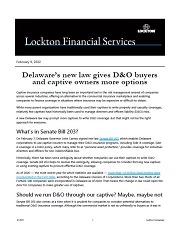Captive insurance companies have long been an important tool in the risk management arsenal of companies across several industries, offering an alternative to the commercial insurance marketplace and enabling companies to finance coverage in situations where insurance may be expensive or difficult to obtain.
While many parent organizations have traditionally used their captives to write property and casualty coverages, relatively few captives have historically been used to manage directors and officers liability (D&O) risks.
A new Delaware law may prompt more captives to write D&O coverage. But that might not be the right approach for everyone.
What’s in Senate Bill 203?
On February 7, Delaware Governor John Carney signed into law Senate Bill 203 (opens a new window), which enables Delaware corporations to use captive insurers to manage their D&O insurance programs, including Side-A coverage. Side-A coverage in a D&O policy, which many refer to as “personal asset protection,” provides coverage for individual directors and officers for non-indemnifiable loss.
Historically, there has been some ambiguity about whether companies can use their captives to write D&O coverage. Senate Bill 203 helps to resolve this ambiguity, allowing companies to consider forming new captives or using existing captives to procure effective D&O coverage.
As of 2020 — the most recent year for which statistics are available — more than 1.6 million legal entities were incorporated in the First State (opens a new window), according to the Delaware Division of Corporations. More than two-thirds of all Fortune 500 companies were incorporated in Delaware as of 2020. That means this change in law could open the door for companies to make greater use of captives.
Should we run D&O through our captive? Maybe, maybe not
Senate Bill 203 also comes at a time when it is prudent for companies to consider potential alternatives to traditional D&O insurance coverage. Although the commercial market is not as unfriendly to buyers as it was in 2020, it remains challenging for some buyers. Pricing continues to increase for many insureds, who are also seeing insurers restrict coverage and impose higher retentions.
Captives can represent an attractive financing alternative to traditional commercial insurance, particularly in times of market volatility. Captives may be able to issue broader coverage terms and conditions than commercial insurers, with more competitive pricing.
In the current marketplace, some companies — life science and cannabis companies, those with digital assets, and those going public or engaging in de-SPAC transactions — may have trouble obtaining cost-effective pricing and appropriate terms and conditions from traditional insurers. So a captive could offer a good solution.
But it may not be the right vehicle for everyone when procuring D&O insurance.
While there may be a benefit to adding D&O insurance to an existing captive that already writes property, casualty, and other lines — namely, diversification of a captive’s risk — there’s also a greater possibility that limits will be exhausted.
Delaware’s new law also requires both notice to shareholders should D&O be put in a captive as well as the imposition of several conduct exclusions to the D&O coverage itself. Depending on the company, it is possible that these exclusions will be more onerous than what the traditional markets are willing to offer.
Finding the right advisor
For these reasons, it is prudent to understand the pros and cons of using a captive for D&O insurance as opposed to buying Side-A coverage through the traditional marketplace.
Accordingly, it is more important than ever to speak with an experienced insurance broker, one that understands both D&O and captives. This broker can help you conduct a cost-benefit analysis that considers what extra value a captive could offer, what you might give up by switching to a captive, and any important limitations you should understand. A broker can also help you file a business plan and amendment to an existing captive that intends to add D&O to its portfolio.
If you do not already have a captive insurer, your broker can help you conduct a feasibility analysis to understand how much capital you’d need to form a new captive, what your governance responsibilities would be, and structural options, including choosing the right captive domicile. Your broker can also help to conduct an analysis to ensure proper funding of D&O risk, which will be required in any captive application.
Delaware’s new law may not be a game-changer for every company, but it’s important that you understand what it means and what new options it could present to you. Talk to your Lockton broker today to learn more.
 Download alert (opens a new window)
Download alert (opens a new window)


